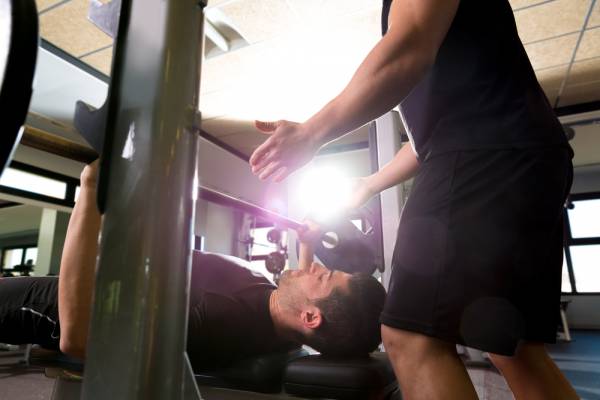Slow, grinding reps are for bodybuilders, right? Heavy negatives? No way, no how. That will just make you slow, right?
Let’s think about it for a minute. Strength and power are pretty much the crux of every sport on the planet aside from darts (which isn’t a sport, but that’s a rant for another day). If you don’t have strength and power, then you’re at nothing. Make sense? Good.
Slow Reps Will Not Make You Slow
Here’s how it works: you need to get strong to have any hope of dominating your sport or event. Of course, it goes without saying for most playing positions in most sports you need some sort of explosive power, too. Do we agree on that? Of course we do.
But won’t slow, grinding reps make you slow? Not necessarily. You just have to be smart about it.
I’m going to talk about muscle growth a lot so remember you’re not thinking of muscle growth as the potential for bigger muscles. Rather, you’re thinking of it as the potential for huge increases in your strength and power. With that, here are six benefits of eccentric reps:
1. Strength is Important For Everything
Studies have shown that your body can tolerate up to 1.75 times more weight eccentrically than it can concentrically. Eccentrics are the downward portion of the exercise, such as lowering yourself in a squat or lowering the bar to your chest in a bench press. It only makes sense to take advantage of this, doesn’t it?
Some sports or events require more size than others, but that’s not for today’s article. If you emphasise the eccentric portion of your lifts, then you’re certain to increase muscle growth. Guess what more muscle growth is going to get you? That’s right, more strength and that means greater potential for hypertrophy (which is always a bonus) and greater potential to develop power. Again, as we talked about at the beginning of this article, power is essential to the vast majority of sports.
I’m not suggesting you do eccentric only training, though. I’m suggesting you take advantage of your body’s potential to handle more weight while still doing the full movement. We’ll get on to how you’re going to do this later, but note that combining the two has been proven to have significant effects on muscle growth.
As you know by now with eccentric training you can lift a hell of a lot more weight than you would normally. The great thing about this is it allows you to workout at a higher intensity. Higher intensity means greater stress, which means greater adaptation. Here’s the beauty of that – the anabolic response from the heavy loads forces greater recruitment of muscle fibres, which by default will allow you to move more weight on the concentric (upward) portion of the lift.
You don’t need to be told what that means, but I’m going to tell you anyway: you get much stronger than you ever would with normal lifting. It’s possible you’ll be moving weight between 20-50% heavier than your regular 1RM. Not too shabby, huh?

2. Greater Muscle Damage
This is why bodybuilders tend to take advantage of slow, grinding reps with moderate weights. It tears their muscles apart and the hope is they will repair and grow even further.
The difference is you are going to use heavy weight and you’re not going to grind out the concentric portion of the lift. In fact, more often than not the concentric portion will be easier than the heavy eccentric.
How you ask? You have two options:
- Have a spotter (sometimes two) on hand to aid you after the heavy eccentric.
- Use lifting aids such as elastic bands, chains or eccentric hooks.
Emphasizing the lowering portion of your lift while still doing the full lift will lead to even greater muscle growth and in turn strength, power and connective tissue development.
3. Stronger Connective Tissue
The stronger your connective tissue (ligaments and tendons), the greater your immunity to injury. Are you under heavy loads all the time in your sport? Do you get hit hard? You need to strengthen your body, not just your muscles. Taking advantage of eccentrics is a great way to do this.
4. You Use Less Energy
Heavier weight uses less energy? That’s nonsense. Again, there is beauty in training eccentric portions of the lift. Most of your energy is used when you’re pushing or lifting a weight. This becomes useful because you are going to be able to do more work, which means your body will improve, your strength will improve, your size will improve, and your power will improve.
5. Greater Flexibility
This one is hard to believe, but there has been a ton of research to show eccentric training actually increases your flexibility. No way, right?
Here’s how it works. The negative portion of the lift causes growth of your muscle fibers, which increases the length of your muscles by increasing the sarcomeres in series within the muscle. Too technical? No problem. Just take my word for it – heavy negatives have been show to promote greater flexibility.
Don’t just take my word for it though. Try it for yourself. Finally, we can dispel the myth that when you lift weights you get less flexible.

6. Greater Power
I’ve already told you that the stronger you are the more potential there is for greater power development. That just makes sense, doesn’t it?
Usually when you are training for power, you will significantly drop your weights to between 30-60% of your 1RM. With heavy negatives you’re going to increase your 1RM, right? So again, by default, you will use heavier weights during your power training, which can only lead to one thing – you being more explosive.
A great way to ensure you remain explosive is to superset your heavy negatives with something fast. Here are two examples:
- Heavy eccentric squat with low rep box jumps.
- Heavy eccentric bench press with low rep explosive push ups or med ball tosses.
Closing Thoughts
This type of training shouldn’t be used year round. Incorporate it into your program periodically to stimulate modest increases in your strength. I highly recommend you do it during your off season. Remember, although you save energy during eccentrics, you are still doing huge amounts of damage to your muscle fibers. Doing this in season will upset your ability to recover. Done correctly, you should expect to get stronger and faster.
Check out these related articles:
- The Expression of Strength, Part 1 – Absolute Strength
- 3 Ways to Use the Kettlebell Swing for Overspeed Eccentric Training
- An Analysis of Muscle Fiber Responses to Eccentric Exercise
- What’s New on Pulse Beat Fit Today
Photos courtesy of Shutterstock.






